CHARLOTTETOWN, P.E.I. — A Charlottetown resident is warning that an unwelcome plant has invaded the city and it can’t be killed.
Barbara Dylla made a presentation recently to city council’s standing committee on environment and sustainability, at the invitation of Coun. Terry MacLeod, the committee’s chairman.
Dylla talked about the heavy prevalence of Japanese knotweed in different areas of the city, although her presentation centred mainly in the residential areas of Upper Prince Street and Walthen Drive.
Japanese knotweed presents a pleasing appearance to the eye: heart-shaped leaves, bamboo stems and pretty, little white-flower tassels. But this plant also has a killer instinct and where it once resided mainly in the wild, is now showing up in private gardens and around homes.
“Japanese knotweed is rated among the 100 most invasive species in the world," said Dylla, who noted that she has been researching the issue for the past year and a half and talking to international invasive species experts.
“The reason why it is so invasive is its ease of spread and rapid growth. It doesn’t take much to grow a new colony."
She said the plant’s roots can cause issues with infrastructure and grow straight through pavement. All it takes is fragments, sometimes spread by a lawn mower, to spread it.
At a glance
The following information was distributed by Charlottetown resident Barbara Dylla on the invasive plant species Japanese knotweed:
- When the plant has reached full growth (flowering stage), cut each stalk to the ground. If a stalk gets pulled out, collect the root, soil, stalk and all fragments.
- Gather and bag stalks and roots carefully.
- Place invasive plants in a clear plastic bag and secure.
- Write plant name or “invasive plant’’ on the bag.
- Place in waste cart. You can also have up to two excess bags beside your cart.
- Smooth out targeted area, remove rocks and any other debris that may damage plastic.
- Cover with thick or multiple layers of tarp/plastic wrap, extending up to two metres beyond plant growth, and weigh down with stones, bricks, planks, soil, etc. The key is to prevent any sunlight from penetrating or knotweed from poking through the tarp/plastic.
Dylla said up until about 10 years ago, the plant was sold at nurseries until jurisdictions started declaring it an invasive species.
She said removing knotweed can be time consuming once the problem is first identified — it should be cut down and carefully disposed of under Island Waste Management Corporation’s invasive species guidelines.
To keep it from growing again, Dylla says to cover it with layers of black tarp and plastic. Some people choose to put soil on top of it, but Dylla said that is an unnecessary expense.
“Anything that is heavy will do and weigh it down at the corners and just monitor for tears or … whatever the plant is trying to get through."
It’s a serious problem people have been dealing with in many parts of the world. In England, for example, companies exist specifically to eliminate Japanese knotweed.
Following Dylla’s presentation, Mayor Philip Brown noted based on the research he has done on the invasive species, the plant can affect property value.
The City of Charlottetown’s website does identify Japanese knotweed as an invasive species it deals with in Victoria Park. The city also works with Maritime Electric to remove it in places.
MacLeod said Dylla’s presentation is an opportunity to spread the word about the plant, suggesting that her information be distributed to the public works and parks and recreation departments.
“Barbara’s information is vital to the community and we can definitely add that to our website," MacLeod said.









